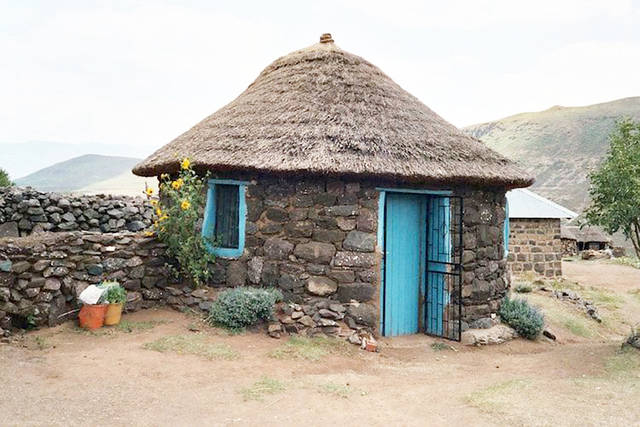Maybe it was the rash of recent news on people becoming homeless, or maybe it was seeing people obviously homeless and camping in their cars or drifting around town that got to me. Maybe it was seeing that worn, young bag lady walking to nowhere special, a droopy bag of belongings tossed over her shoulder.
Or maybe it was the TV spot of a father moved to tears as he expressed his gratitude to the Office of Hawaiian Affairs for getting his family into an affordable small home, something he never thought would happen.
Not one, but the combination of triggers worked on me along with the emotionally-charged fact that I, myself, had faced the fact of becoming homeless not once, but twice. I lay sleepless.
Images played unbidden on the inner screen of my mind — not only of the various types of dwellings human beings have developed in various cultures around the world and through time, but the humans that developed and built those differing habitats themselves.
• Caves: The first safe dwellings, to be sure. I recalled reading “Clan of the Cave Bear” and suffering along with Ayla, who didn’t fit with her rescuers in the monkey-like tribe. Also, my first visit walking into the gaping maw of the Ha‘ena dry cave, which I later learned sheltered the first Kauai fishermen who came from other parts of the island to camp in now-hidden upper chambers within it. My mind skipped on to the Maha‘ulepu “cave” when I first saw it after ducking through a dark entry tunnel with a skull-bonking protrusion to be avoided at all costs, and before the special archaeological digs and protections now in place. There were my more recent memories of the amazing, ancient sandstone clefts of Jordan’s Petra, both manmade and naturally formed.
• Castles: These are part of every person’s inner kid imaginings, whether “fairy” or Disney-style imaginings, or defined by ramparts and knights of old, such as my oldest son played with (a Sears Christmas gift) for countless hours.
• Sumptuous tents of Araby: Inner visions bloomed of sumptuous Persian carpets, skinny minarets and silken draperies — Ali Baba-type settings.
• Indian “daks” or godowns: Small, roughly constructed dwellings to which servants retired to eat and sleep from the bungalows of my youth.
• Igloos: I wondered as a school kid how anyone slept on an ice-shelf bed, furry robes or not. And how did the Eskimos cut those great blocks of ice and manage to sculpt them to fit into a curved shape?
• Stilt homes: All through Asia, these protect from flooding, insects and wild animals. Their sloped roofs channel off the rain.
• Yurts: My fifth-grade Junior Scholastic implied that the lives of Mongolian nomads centered around a home fashioned of hides and poles. How did the mothers feel about pulling up stakes to move so often, and how did they find time to embroider and fashion the prayer cloth hangings?
• Teepees, wigwams, hogans: I held the same questions for the North American tribes, and when did their girls and women get any privacy, and how did they store their beading and hide-sewing supplies without plastic boxes and compartmental “keepers”?
• Hale: Visualizing the thatched dwellings of Polynesian cultures. I once said such would be my dream house — if it were situated with a view of the ocean on golden sand under coconut palms (AND allowed me to hook up to a modem and Wi-Fi!). Now, after experiencing recent heavy, driving rains in “paradise” and remembering Hurricane ‘Iniki, I’ve rethought that idea.
The house a human calls home becomes part of that individual’s foundation, leading to the impact of the phrase “home, sweet home.” There comes a point in a life when backpacking and caravanning end, where one decides to plant one’s self and perhaps some trees and vegetables, and create a safe haven in which to raise a family.
Toddlers show the importance of home in some of their first drawings when, in our culture, the stick figures identified as mommy and daddy and self are shown with a dominant house. Sometimes this house has a door and windows; sometimes, a chimney and/or flowers. No matter the variations, the house looms, showing its importance as “home.” To be homeless erodes this foundational feeling of stability.
So, whether it’s an igloo, hut, hovel or mansion, or underground “oasis” house of Coober Pedy, Australia, or a rondavel of Lesotho, South Africa, what matters is that one may call it home.
Homelessness on our island is not just about people who are down and out, people who may or may not choose to enter another level of society. Responsible people who do work hard and earn decent wages are going homeless.
The crisis at hand centers on not having enough truly affordable home properties and rentals available to our full-time residents. It’s a fact that Kauai people cannot easily find affordable housing, that the inflated housing costs and jacked-up rents are causing even good earners to join the ranks of the homeless.
It’s dishonest to permit and label dwellings “affordable” that are, in fact, not so, or fall out of that category back to market price within 10 years. It’s not enough to discount permitting costs for home additions.
Dear Readers, I implore you to brainstorm and submit your ideas for creative solutions to The Garden Island’s Forum for publication with copies to the appropriate county department heads, charging them to act on this matter, perhaps improvising on the housing innovations just now being implemented on Hawaii island.
•••
Dawn Fraser Kawahara, author and poet, made her home on Kauai in the 1980s. She and her husband, a retired biology teacher, live with books, music and birds in Wailua Homesteads. Shared passions are travel and nature. The writer’s books may be found in local outlets and on Amazon. Email her at tropicbirdpress@gmail.com.


